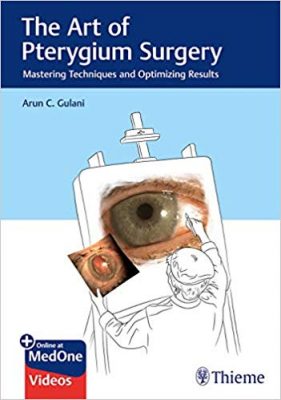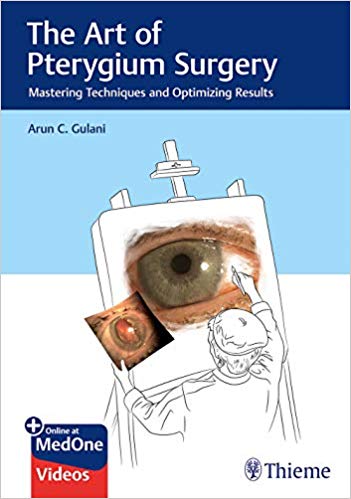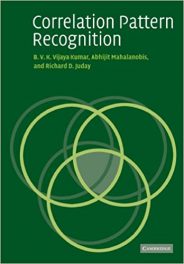 Editor: Arun C. Gulani, MD
Editor: Arun C. Gulani, MD
Publisher: Thieme – 163 pages
Book Review by: Nano Khilnani
Excellent outcomes has been the desire, and the ultimate goal of this book’s editor Dr. Arun Gulani in all his work, dating as far back as on his days as a resident in ophthalmology, and perhaps even way before that.
Many of us have heard the saying: “Where there is a will, there is a way.” If your will is to perform at your peak level, then by all means arm yourself with the latest available knowledge in your sub-specialty within your specialty, familiarize yourself with the latest technology tools, and finally, practice, practice, and practice some more, till you become perfect (or almost perfect if perfection is impossible). Then achieve excellent outcomes for all your patients.
Pterygium is a pathology of the human eye discovered many centuries ago. It has been documented in Egyptian hieroglyphics. Hippocrates, known as the ‘father of medicine’ mentioned in the fourth century BC, the substances that can be used to treat it, or reduce its adverse effects. (Hippocrates wrote more than 70 books, and described in a scientific manner, many diseases and their treatment, after observations). .
India’s Sushrata, probably the world’s first surgeon ophthalmologist, described around 1000 BC, this surgical procedure: “The patient must lie on a table. The pterygium is sprinkled with salt. The patient looks laterally, and the most superficial part of the pterygium is clasped with a book. Then, the pterygium is detached from the ocular surface with a knife with a round end but sharp cutting edge. The remnants adhered to the eye must be eliminated, and an unguent applied, in order to avoid the recurrence.”
What about today? Dr. Arun Gulani and Dr. Parth Patel, in chapter 1 – Pterygium: History and Overview write:
“Modern approach to treatment includes using ocular lubricants to treat dry eye during the early stages of the disease. Surgical treatment is conventionally indicated when the lesion is large, threatens vision, causes significant discomfort, or is cosmetically unacceptable. Surgical methods include a wide range of procedures from the simple bare sclera technique to the complex keratoplasty and amniotic membrane transplantation. All these techniques aim to minimize recurrence, which is the biggest problem encountered in treating pterygia.”
“The current surgical approaches can broadly be divided into the following:
- Bare sclera excision
- Excision with conjunctival closure
- Excision with amniotic adjunctive therapies
- Ocular surface transplantation techniques.”
Thirty-one specialists in ophthalmology and its sub-specialties, from all over the United states and four other countries – Australia, Egypt, India, and Spain – authored or coauthored the 16 chapters of this book we list below as an overview of its contents:
- Pterygium: History and Overview
- Classic Signs, Symptoms, Classification, and Differential Diagnosis of Pterygium
- Current Concepts in Treatment of Pterygium – An Evidence-Based Review
- Evolution of the Medical and Surgical Treatments for Pterygium
- Ocular Surface and Tear Film Management in Pterygium Surgery
- Amniotic Membrane and Umbilical Cord as Platform Technology to Promote Regenerative Healing
- Conjunctival Autograft for Primary and Recurrent Pterygium: Past, Present, Future
- Amniotic Graft Surgery in Ocular Surface Pathologies besides Pterygium
- Mitomycin C, Glues, Sealants, and Ancillaries in Pterygium Surgery
- Nonsurgical management of Irregular Astigmatism Associated with Pterygium
- Stem Cell Applications in Pterygium
- Surgical Approach to Isolated and Associated Presentations of Pterygium
- Complications of Pterygium Surgery
- Complex Pterygium Surgery and Complication Management to Cosmetic Endpoints
- Pterygium and Pinguecula Surgery: Next-Day Cosmetic Outcomes
- Kerato-Refractive and Premium Cataract Surgery with Pterygium
Access your free e-book now!
With three easy steps, unlock free access to your e-book: 1. Scratch off the film found on the inside front cover of your book. 2. Scan the QR code or enter your access code at MedOne.Thieme.com/code. 3. After you successfully register and activate your code, you can find your book and additional online media at:
www. MedOne.Thieme.com / 97816726235113
Video Contents
- Section 1- Pterygium and Pinguecula Surgery
- Video 1 – Sutureless Amniotic Pinguecula Surgery
- Video 2 – Sutureless Amniotic Pterygium Surgery
- Video 3 – Sutureless Amniotic Recurrent Pterygium Corrective Surgery
- Video 4 – Mild Pterygium Surgery
- Video 5 – Moderate Pterygium Surgery
- Video 6 – Large Pterygium Surgery
- Video 7 – Bitemporal Pterygium Surgery
- Video 8 – World’s First 3-D Pterygium Surgery
- Video 9 – Topical, Cautery-Assisted Pterygium Excision with Limbal-Conjunctival Autograft Using Tissue Glue
- Video 10 – Pterygium Excision
- Section II – Recurrent Pterygium Corrective Surgery
- Video 11 – Recurrent Pterygium
- Video 12 – Cystic Recurrent Pterygium
- Video 13 – Bitemporal Recurrent Pterygium
- Section III – Repairing Surgical Complications
- Video 14 – Repairing Surgical Complications
- Video 15 – Refractive Amniotic Surgery
- Video 16 – Cosmetic Amniotic Surgery in Band-Shaped Keratopathy (BSK)
- Section IV – Dissection Pearls
- Simple Pinguecula / Pterygium
- Complex Recurrent Pterygium
- Pterygium Surgery Day with Dr. Gulani (Overhead Camera View)
- Section V – Patient Reactions
- Video 20 – Day 1 Post Op Pterygium / Pinguecula Surgery in the Mirror
- Video 21 – 16 Years Later Post Op Pterygium / Pinguecula Surgery
In sum, this is an excellent, highly detailed, and amply illustrated book on this subject, with a concise conclusion at the end of each chapter, plus thousands of additional reference works on pterygium surgery listed at the end of each of its chapters. We found only six books with the word ‘pterygium’ on Amazon’s website, and right on the top was this book. Great work!
Editor:
Arun C. Gulani, MD, MS is the Founding Director and Chief Surgeon at Gulani Vision Institute in Jacksonville, Florida.







